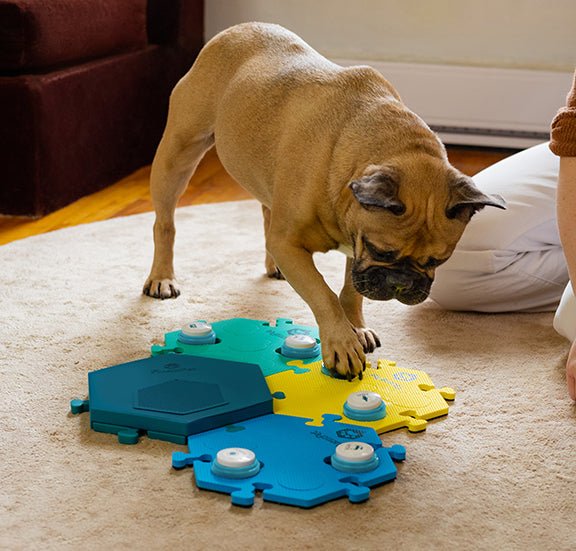The fictional Dr. Dolittle is famous for his “magic” ability to understand what animals think and feel. If you have lived with dogs, at some point you have probably wished that you had some of Dolittle’s magic, that your dog would one day just open up and talk to you. You’ve likely also wondered what dogs would choose to say if they could.
But the truth is, dogs do tell us things, all of the time. Just like any relationship, deepening our connections with dogs is not just about talking, but about learning how to listen.
From head to tail, pay attention to the “whole dog”
One way for us to be better listeners when it comes to dogs is to become familiar with canine body language and be aware of the ways our own body language might influence a dog’s behavior. While people tend to focus on faces when we’re communicating with one another, dogs often use their whole bodies to articulate complex emotions.
In a sense, a picture is worth a thousand words when trying to decipher what a dog is telling you, another person, or even another dog. With that in mind, how would you view a painting if you wanted to get a sense of the artist’s intent? You might start by scanning the entire canvas, and then focusing in on the areas where the action is centered. You can use a similar strategy to read your dog.

What their eyes are telling you
Is the dog squinting or staring? Are their eyes widened or in a resting state? Some dogs “smile” with their eyes in the way that humans do. Conversely, a widened eye looking sideways is an expression known as “whale eye.” This is a signal of apprehension and can mean a dog is afraid or feeling antisocial.

What their mouth is telling you
When dogs open their mouths, their teeth show. This does not automatically mean they are intending to be threatening. For example, a tight-lipped, closed mouth may be more of a sign of stress or displeasure than an open mouth with a lolling tongue. But if their upper lip is curled, teeth are bared, and they are snapping and lunging, the dog is clearly being actively aggressive— though the reasons they may be displaying those behaviors can vary greatly.

What their ears are telling you
Ears, too, can be telling (they are not just for listening). Think about when you’ve seen a dog’s ears pricked up, or flattened, or lowered, or perhaps scrunched a little toward the midline of their head as if they were curious. What else did you notice in each of these instances? If a dog’s ears are flattened against the side of their head, they are most likely concerned about something, and maybe even afraid. Pricked ears, on the other hand, usually indicate attention.

What their body is telling you
The position and movement of a dog’s shoulders, rump, and tail are all also good indicators of what a dog is trying to convey. If their shoulders or haunches are tense and hackles are raised, it’s probably a good bet that they’re not feeling very happy. If their butt is wiggling loosely it’s much more likely that they are relaxed than if it is lowered and tucked toward the ground.

What their actions are telling you
When a pup pounces on their front paws with butt in the air and tail wagging merrily, that’s a sure sign that they’re ready to play. Other types of animals, especially younger individuals, make similar gestures when signaling that they are being rowdy but not aggressive, and for this reason the motion is known as a “play bow”… for any Yogis out there, you know that “puppy posture” is so-named with good reason!

What their tail is telling you
Some of the most “tell-tale” signs a dog can give come, of course, from the tail. Contrary to popular opinion, a wagging tail doesn’t always mean a dog is having fun. Tail wags can be thought of like laughs— they come in many cadences. Some are cheerful and hearty, some silly, some nervous, and some sinister. A loose, floppy wag or even an energetic side wiggle are very different from a tail held high moving stiffly back and forth, or one moving in fast circular motions. These latter two mean the dog is poised, on alert, and may ultimately be feeling upset.
Context is crucial when it comes to canine conversations
In general, canine body language is not entirely different from our own. A happy, relaxed dog will have a loose body. A happily excited dog’s body may not be quite so at ease, but their other movements and vocalizations will signal that they are not likely experiencing negative emotions. An angry or fearful dog, on the other hand, will most always appear tense, stiff, and uncomfortable.
Dogs may also use more obvious and general signals, such as moving closer to you when they want to snuggle, or toward a new toy in curiosity, or moving away from someone or something they don’t like or are disinterested in. These decisions should be respected and a dog should not be forced into an interaction they don’t want to have.
Viewing the whole canvas of a dog will help you learn to understand canine body language, but it is also important to remember that the same movement, vocalization, gesture, or expression can vary in meaning across different scenarios.
It’s important to consider things like whether or not the dog has met another dog or person before, or if they are strangers, and whether they are meeting in a familiar or unfamiliar space. Elements unique to every interaction will impact the way a dog communicates. For example, snapping and biting the context of one-on-one play with another dog may not be problematic if it is bouncy and accompanied by those play bows and turn-taking. But nipping and snapping when someone approaches a dog’s toy, or walks near a food bowl, is an aggressive behavior called resource guarding.
Why is learning how to read “dog” important?
Like people, dogs live rich emotional lives, and they express themselves in many ways. The more we understand what they are trying to say, the better companions and caregivers we can be. Knowing what signs to look for to determine whether a dog might be getting overwhelmed before their behavior turns aggressive can mean the difference between a dog fight and a successful social interaction. Subtle cues can be indicators of whether they are afraid, hurt, or sick. And understanding individual dogs’ behaviors and dialects can be especially important in welfare situations.
Above all, learning to “read” a dog’s language helps us support their autonomy and choice, and builds stronger bonds with the canines we love.





Leave a comment
This site is protected by hCaptcha and the hCaptcha Privacy Policy and Terms of Service apply.